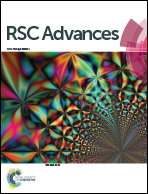Removal of antimonite (Sb(iii)) and antimonate (Sb(v)) using zerovalent iron decorated functionalized carbon nanotubes
Abstract
Carbon nanotubes (CNT) were synthesized by floating catalytic chemical vapor deposition method using ferrocene and benzene as hydrocarbon source. The prepared CNTs were oxidized with nitric acid (CNT-OX) followed by coating with nano zerovalent iron (ZVI) to yield nano ZVI decorated CNTs (CNT-Fe(0)). The prepared adsorbents were characterized by various techniques. Using spectral techniques like infra red, Raman and X-ray photoelectron spectroscopy, the mechanism of adsorption between the adsorbent and adsorbate has been postulated. Using CNT-Fe(0) at pH 5, the maximum adsorption capacity of Sb(III) and Sb(V) was found to be 250 mg g−1. The high sorption capacity could be attributed to the high surface area of the prepared CNTs and the reactive nature of the nano zerovalent iron particles on CNTs. A pseudo second order kinetics was followed by CNT-Fe(0) with both Sb(III) and Sb(V) with a rate constant of 0.0015 and 0.0011 mg g−1 min−1 respectively. The interference effect of various ions on the adsorption of Sb(III)/Sb(V) are as follows: PO43− > SiO32− > ASO43− > SO42−, NO3− > Cl−, humic acid. The recyclability of the sorbent was demonstrated for 5 cycles using 0.05 M HCl as desorbent. The versatility of the adsorbent was demonstrated by the removal capacity of both Sb(III) and Sb(V) at parts per billion levels from nuclear decontamination formulation (NAC) and tap water matrix as well.


 Please wait while we load your content...
Please wait while we load your content...